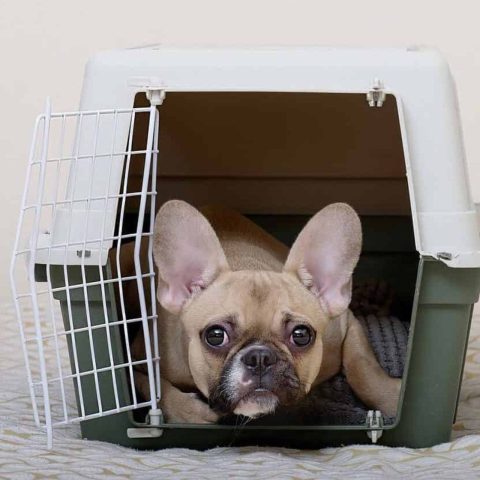You’ve probably seen it before – a bulldog pacing back and forth, whimpering, and panting, clearly distressed in a new environment. This anxiety can be overwhelming for both the dog and its owner. But what if you could create a sense of calm and security for your bulldog? By implementing the right crate training strategies, you can help your furry friend feel more at ease. But where do you start? Let’s explore three essential tips to get you on the right track, from creating a safe space to choosing the perfect crate size and training at the right time.

Create a Safe Space Immediately
By designating a specific area of your home as a ‘den’ and outfitting it with a comfortable crate, you can immediately create a safe space for your anxious bulldog to retreat to when feeling overwhelmed. This quiet corner will become a haven where your bulldog can escape the chaos and find peace. To maximize the calming effects, consider adding calming aids such as pheromone diffusers, calming music, or a calming mat. These tools can help reduce your bulldog’s stress levels and create a sense of tranquility.
When setting up the den, make certain it’s easily accessible and quiet, allowing your bulldog to feel secure and relaxed. You can also add a few comfort items like a favorite toy or blanket to make the space feel more inviting. By providing a safe space, you’re giving your anxious bulldog the opportunity to self-soothe and regulate their emotions. This can be a game-changer for their overall well-being and can help reduce anxiety-related behaviors.
Choose the Right Crate Size
Selecting a crate that’s tailored to your bulldog’s unique size and needs is essential, as a crate that’s too small can exacerbate anxiety, while one that’s too large can render the space less comforting. To guarantee you’re getting the right fit, measure your bulldog’s length, width, and height using the following methods:
| Measurement Method | Description |
|---|---|
| Length | Measure from the tip of the nose to the base of the tail |
| Width | Measure the widest part of the body, usually around the shoulders |
| Height | Measure from the top of the head to the paw pads |
When choosing a crate, consider the material as well. Plastic crates are easy to clean, while metal crates provide better ventilation. Wooden crates can add a cozy touch, but may require more maintenance. Remember to add 2-4 inches to each measurement to confirm your bulldog has enough room to stand up, turn around, and lie down comfortably. By selecting the right crate size and material, you’ll create a safe and comforting space for your bulldog to thrive.
Crate Training at Night Only
One effective approach to crate training for bulldog anxiety is to start by confining their crate time to nighttime only, allowing your bulldog to gradually adjust to the new space while still having freedom during the day. This approach helps your bulldog associate the crate with calmness and relaxation, rather than feeling trapped or confined. As you establish a consistent nighttime routine, your bulldog will learn to settle down in their crate, surrounded by a quiet environment that promotes relaxation.
During the night, the crate provides a sense of security and comfort, helping to alleviate anxiety and stress. You can also add a familiar object, like a favorite toy or blanket, to the crate to create a sense of familiarity and reassurance. By introducing crate training at night only, you’re giving your bulldog the space to adjust and adapt at their own pace, which is essential for building trust and confidence. As your bulldog becomes more comfortable with the crate, you can gradually increase their crate time during the day, helping them to feel more calm and relaxed in their new space.
Frequently Asked Questions
Can I Crate My Bulldog When I’m Not at Home?
When you’re away, you can crate your bulldog, but prioritize Puppy Safety by ensuring they’re not left alone for too long, as Home Alone situations can exacerbate anxiety – start with short periods and monitor their comfort.
How Long Does It Take for a Bulldog to Adjust to a Crate?
You’ll be relieved to know that it typically takes a bulldog 1-3 weeks to adjust to a crate, depending on crate comfort and your puppy patience, with gradual introduction being key to a smooth adaptation.
Will Crate Training Help With Separation Anxiety in Bulldogs?
As you prepare to leave, your bulldog’s anxious heart beats like a drum, but crate training can be a soothing melody, helping to calm the storm by minimizing Anxiety Triggers and incorporating Calming Aids, giving you peace of mind.
Can I Put My Bulldog’s Favorite Toys Inside the Crate?
You can definitely put your bulldog’s favorite toys inside the crate to create a cozy atmosphere, but be mindful of toy placement to guarantee they don’t obstruct the crate’s comfort and your bulldog’s ability to move around freely.
Are There Any Crate Training Alternatives for Bulldogs?
“You’re looking for a cozy retreat alternative, aren’t you? Consider Exercise Pens or Play Yards, which offer a sense of security and freedom, perfect for bulldogs who need a little extra comfort and space to unwind.”
Conclusion
As you venture on this calming journey with your bulldog, remember that a well-crafted den is the sanctuary they’ve been searching for. By creating a safe space, selecting the perfect crate, and introducing it at night, you’ll be weaving a tapestry of trust and tranquility. Your bulldog will snuggle into their new haven, feeling the weight of anxiety lift like a stormy cloud parting to reveal a sunny sky. With patience and persistence, their den will become a symbol of comfort, a beacon of calm in a chaotic world.
